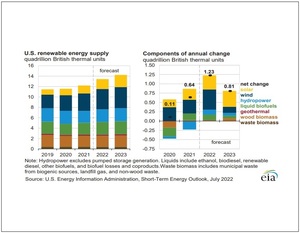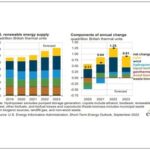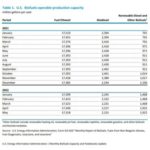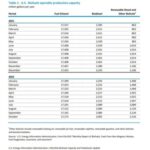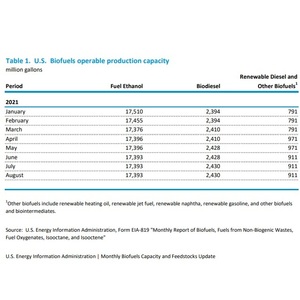EIA updates bioenergy production, capacity forecasts
Energy Disrupter
ADVERTISEMENT
Renewables are expected to account for 22 percent of U.S. electricity generation this year, increasing to 24 percent in 2023, according to the U.S. Energy Information Administration’s latest Short-Term Energy Outlook, released July 13. Renewables accounted for 20 percent of U.S. electricity generation in 2021.
The electric power sector generated 27.9 billion kilowatt hours (kWh) of electricity from biomass last year, including 15.5 billion kWh from waste biomass and 2.14 billion kWh from wood biomass. Biomass generation is expected to fall to 26.3 billion kWh in 2022, including 14.7 billion kWh from waste biomass and 11.5 billion kWh from wood biomass, and 26.1 billion kWh in 2023, including 14.8 billion kWh from waste biomass and 11.3 billion kWh from wood biomass.
Across other sectors, biomass generation was at 27.6 billion kWh last year, including 2.8 billion kWh from waste biomass and 24.8 billion kWh from wood biomass. Biomass generation is expected to be at 27.3 billion kWh this year, including 2.85 billion kWh from waste biomass and 24.5 billion kWh from wood biomass. Generation is expected to be maintained at 2022 levels through 2023.
The electric power sector is expected to consume 0.228 quadrillion Btu (quad) of waste biomass this year, increasing to 0.229 quad next year. The sector consumed 0.236 quad of waste biomass in 2021. The electric power sector consumed 0.199 quad of wood biomass last year, with consumption expected to fall to 0.188 quad this year and 0.184 quad in 2023.
The industrial sector is expected to consume 0.163 quad of waste biomass in both 2022 and 2023, up from 0.16 quad in 2021. The sector consumed 1.342 quad of wood biomass in 2021, with consumption expected to increase to 1.361 quad this year and 1.436 quad next year.
The waste biomass sector consumed 0.035 quad of waste biomass last year. Consumption is expected to increase to 0.036 quad this year and remain at that level in 2023. The sector also consumed 0.083 quad of wood biomass last year. That level of consumption is expected to remain flat through 2022 and 2023.
The residential sector is expected to consume 0.469 quad of wood biomass in 2022 and 2023, up from 0.464 quad last year.
Across all sectors, the consumption of wood biomass was at 0.431 quad in 2021. Consumption is expected to fall to 0.43 quad this year and 0.428 quad next year. Waste biomass consumption was at 0.287 quad last year and is expected to increase to 2.1 quad this year and 2.171 quad in 2023.
The electric power sector had 5,977 megawatts (MW) of biomass capacity in place at the end of 2021, including 3,674 MW of waste biomass capacity and 2,303 MW of wood biomass capacity. Biomass capacity is expected to increase to 6,001 MW by the end of this year, including 3,698 MW of waste biomass capacity and 2,303 MW of wood biomass capacity. Capacity is expected to fall to 5,920 MW by the end of 2023, including 3,618 MW of waste biomass capacity and 2,303 MW of wood biomass capacity.
Across other sectors, biomass capacity was at 6,214 MW at the end of 2021, including 829 MW of waste biomass capacity and 5,385 MW of wood biomass capacity. Biomass capacity is expected to expand slightly to 6,217 MW by the end of this year, including 828 MW of waste biomass capacity and 5,389 MW of wood biomass capacity. Biomass capacity is expected to fall to 6,209 MW by the end of 2023, including 828 MW of waste biomass capacity and 5,381 MW of wood biomass capacity.

